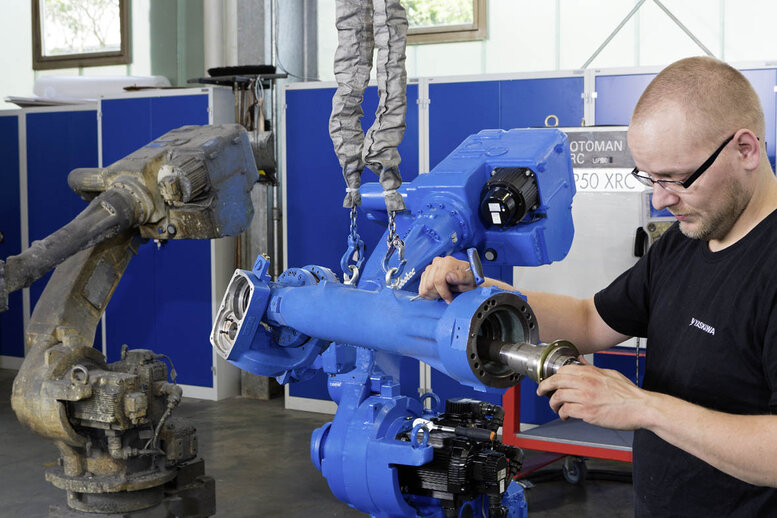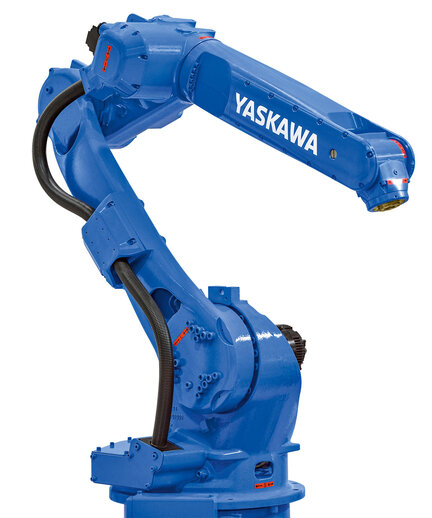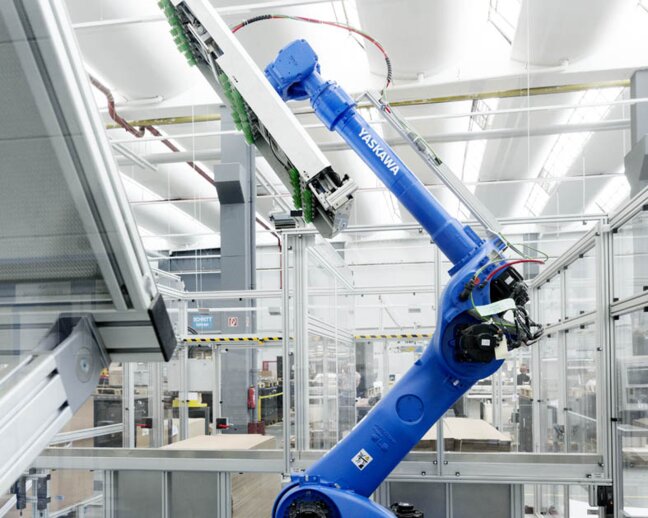Our industry-leading, high-speed industrial robots include high-payload, extended-reach, ultra-maneuverable seven-axis and unique 15-axis dual-arm robots.
Sustainability in industrial robots
Efficiency potential in manufacture and operation
When it comes to sustainability in industrial production, robots offer considerable, often unexploited savings potential, enabling more efficient use of energy and materials.
Key approaches are, for example, extended service life, increased energy efficiency in ongoing operation or optimised manufacture and logistics.
Longer service life through systematic retrofit
Employing a robot for as long as possible is not only cheaper than acquiring a new device, it is also a resource-saving strategy. In development, Yaskawa has thus long-since adopted a policy of marketing only highly durable products. Whereas these were previously designed for a total service life of eight to maximum twelve years, today many MOTOMAN robots are still in use after 30 years.
The actual robot life cycle of about eight years has, however, remained unchanged. This raises the question of what happens to the robot after this period. In the past, it was simply replaced after about eight years by a new one, but under sustainability aspects the goal should be to extend its operability beyond the first life cycle.
One possibility, at least theoretically, is to simply continue to use the robot after the calculated end of its life cycle and to have it repaired in the event of a breakdown. But such repairs often take several days – even if a service technician is immediately available and the cause can be quickly diagnosed. During this time, production is at a stillstand. Depending on the actual damage, the repair costs are difficult to calculate. Travel and ancillary costs are incurred, and finally the prevailing conditions for a repair in the production environment are usually not ideal, e.g. limited accessibility and the frequent lack of lifting and transporting equipment or cargo cranes. Unplanned repairs on site should therefore be limited to absolute emergencies.
In this case a so-called retrofit, by which an aging MOTOMAN robot is refurbished or replaced (Fig. 1), makes more sense. Yaskawa offers both solutions: in a major overhaul the robot is completely dismantled at the robotics plant at Allershausen and restored to an almost mint condition. The robot is then returned to the customer. This program is to be recommended when the robot will not be needed for a prolonged time, for example, after a product change. However, the solution often has to be expedited. In this case, an exchange of the robot by an already reconditioned identical model with identical specifications is preferable. This replacement requires only a readjustment of work programs and can be accomplished within the space of a few hours.
Apart from the time aspect, both retrofit programmes – general overhaul and replacement – offer the same general benefits: the warranty on replaced components is renewed for one year. A guaranteed fixed price that is oriented to the robot’s load-carrying capacity offers maximum investment security. The existing control unit, existing spare parts and all system peripherals can continue to be used without the need for new investment. Machine hour prices are reduced. In addition, there are no costs for reprogramming and employee training. And last but not least, the use of an identical model does not constitute a “substantial modification to machinery” within the meaning of EC Machinery Directive (MachRL/2006/42/EC). No new safety test and no new CE marking are thus necessary.
Efficient operation by energy recovery
With reference to energy efficiency, the first thing to consider is the average CO2 equivalent (global warming potential, GWP) of the three phases of the robot life-cycle. The least amount of CO2 is produced during the “end-of-life” phase, where energy can be returned to the system according to recycling principles. By far the highest proportion occurs – unsurprisingly – during the use phase, particularly when it lasts many years. The more resource-saving they work in ongoing operation, the more robots will contribute to the realization of sustainability.
Energy can already be saved in the intelligent control of operational processes, such as the automatic shutdown of production facilities in planned operational breaks. But there are also robot-specific energy-saving solutions. In their very diverse tasks, be it handling, palletizing, joining or machining, industrial robots also perform many downwards or sideways movements, during which their servomotors dissipate energy. Until now, older or other robot models on the market converted this energy into waste heat by means of electrical resistors, and released it unused into the environment.
Yaskawa has now developed a technical solution by which the electric energy can also be fed back into the power grid without additional hardware and re-used (Fig. 2). All larger MOTOMAN robots with payloads upwards of approx. 50 kg and the latest YRC1000 robot controls are able to convert kinetic energy from downwards and sideways movements directly into 400 V alternating current at 50 Hz and feed it back into the grid.
Depending on the tasks involved and individual movement patterns, the energy needs of the robot can thus be significantly reduced. Empirical values are in the 8% to 25% range. Annual savings of about 2,800 KWh per robot can be achieved. That is approximately equal to the power consumption of a three-person household and corresponds to about 1,600 kg of avoided CO2 emissions or well over 1,000 euros in saved electricity costs.
Further efficiency potential is realised by MOTOMAN robots due to their slim and compact design with low moving masses and the rapid application of brakes during movement pauses, which disables the active position control when not in use.
Sustainability in manufacturing and logistics
As a supplier and company as a whole, Yaskawa has also set itself high sustainability goals: not only in Europe, but worldwide, the technology group aligns its activities to the 17 UN sustainable development goals and promotes the use of its products for sustainable projects, e.g. irrigation, placement, sowing and efficient food production in smart agriculture for a more sustainable and worthwhile future. Through the sales of resource-efficient products the company aims to contribute globally to savings equivalent to 100 times the self-induced CO2 emissions by 2025.
And Yaskawa relies – not only, but also in the field of robotics – on Europe as a production site: Yaskawa’s robot manufacturing plant in Kočevje/Slovenia, opened in 2018, today satisfies almost 90% of the European demand for MOTOMAN robots. That not only avoids the CO2 and exhaust emissions from thousands of saved transport kilometres, it also shortens the delivery times for European customers and users.






















